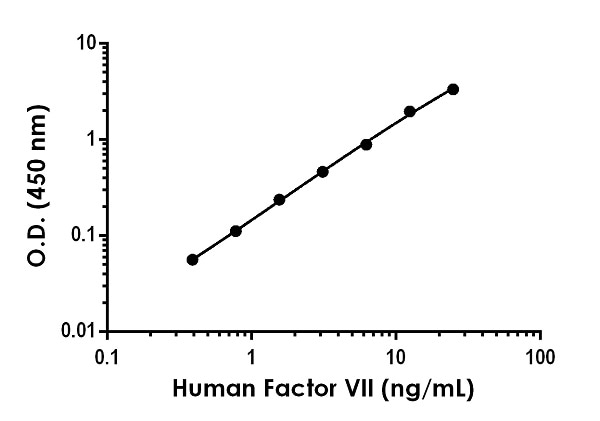Human Factor VII ELISA Kit (ab190810)
Key features and details
- One-wash 90 minute protocol
- Sensitivity: 0.16 ng/ml
- Range: 0.39 ng/ml - 25 ng/ml
- Sample type: Cell culture supernatant, Cit plasma, EDTA Plasma, Hep Plasma, Serum
- Detection method: Colorimetric
- Assay type: Sandwich (quantitative)
- Reacts with: Human
Overview
-
Product name
Human Factor VII ELISA Kit
See all Factor VII kits -
Detection method
Colorimetric -
Precision
Intra-assay Sample n Mean SD CV% Serum 8 6.2% Inter-assay Sample n Mean SD CV% Serum 4 6.5% -
Sample type
Cell culture supernatant, Serum, Hep Plasma, EDTA Plasma, Cit plasma -
Assay type
Sandwich (quantitative) -
Sensitivity
0.16 ng/ml -
Range
0.39 ng/ml - 25 ng/ml -
Recovery
Sample specific recovery Sample type Average % Range Cell culture supernatant 91 80% - 93% Serum 89 82% - 96% Hep Plasma 91 83% - 97% EDTA Plasma 85 80% - 93% Cit plasma 101 92% - 106% -
Assay time
1h 30m -
Assay duration
One step assay -
Species reactivity
Reacts with: Human -
Product overview
As of July 17, 2020, Human Factor VII ELISA kit has been re-developed with new recombinant monoclonal antibodies to provide improved performance and consistency. Please note the protocol has also been updated.
Human Factor VII ELISA Kit (ab190810) is a single-wash 90 min sandwich ELISA designed for the quantitative measurement of Factor VII protein in cit plasma, hep plasma, serum, and edta plasma. It uses our proprietary SimpleStep ELISA® technology. Quantitate Human Factor VII with 292 pg/ml sensitivity.
SimpleStep ELISA® technology employs capture antibodies conjugated to an affinity tag that is recognized by the monoclonal antibody used to coat our SimpleStep ELISA® plates. This approach to sandwich ELISA allows the formation of the antibody-analyte sandwich complex in a single step, significantly reducing assay time. See the SimpleStep ELISA® protocol summary in the image section for further details. Our SimpleStep ELISA® technology provides several benefits:
- Single-wash protocol reduces assay time to 90 minutes or less
- High sensitivity, specificity and reproducibility from superior antibodies
- Fully validated in biological samples
- 96-wells plate breakable into 12 x 8 wells stripsA 384-well SimpleStep ELISA® microplate (ab203359) is available to use as an alternative to the 96-well microplate provided with SimpleStep ELISA® kits.
-
Notes
Factor VII is a plasma serine protease involved in the coagulation cascade. Processed in the liver, it circulates in the bloodstream as a zymogen. During coagulation it is converted to factor VIIa by factor Xa, factor XIIa, factor IXa, or thrombin. Factor VIIa can then convert factor IX to IXa in the presence of tissue factor and calcium.
-
Platform
Microplate
Properties
-
Storage instructions
Store at +4°C. Please refer to protocols. -
Components 1 x 96 tests 10X Human Factor VII Capture Antibody 1 x 600µl 10X Human Factor VII Detector Antibody 1 x 600µl 10X Wash Buffer PT (ab206977) 1 x 20ml 50X Cell Extraction Enhancer Solution (ab193971) 1 x 1ml Antibody Diluent 4BI 1 x 6ml Human Factor VII Lyophilized Purified Protein (ab62386) 2 vials Plate Seals 1 unit Sample Diluent NS (ab193972) 1 x 50ml SimpleStep Pre-Coated 96-Well Microplate (ab206978) 1 unit Stop Solution 1 x 12ml TMB Development Solution 1 x 12ml -
Research areas
-
Function
Initiates the extrinsic pathway of blood coagulation. Serine protease that circulates in the blood in a zymogen form. Factor VII is converted to factor VIIa by factor Xa, factor XIIa, factor IXa, or thrombin by minor proteolysis. In the presence of tissue factor and calcium ions, factor VIIa then converts factor X to factor Xa by limited proteolysis. Factor VIIa will also convert factor IX to factor IXa in the presence of tissue factor and calcium. -
Tissue specificity
Plasma. -
Involvement in disease
Defects in F7 are the cause of factor VII deficiency (FA7D) [MIM:227500]. FA7D is a rare hereditary hemorrhagic disease. The clinical picture can be very severe, with the early occurrence of intracerebral hemorrhages or hemarthroses, or, in contrast, moderate with cutaneous-mucosal hemorrhages (epistaxis, menorrhagia) or hemorrhages provoked by a surgical intervention. Numerous subjects are completely asymptomatic despite a very low F7 level. -
Sequence similarities
Belongs to the peptidase S1 family.
Contains 2 EGF-like domains.
Contains 1 Gla (gamma-carboxy-glutamate) domain.
Contains 1 peptidase S1 domain. -
Post-translational
modificationsThe vitamin K-dependent, enzymatic carboxylation of some glutamate residues allows the modified protein to bind calcium.
The iron and 2-oxoglutarate dependent 3-hydroxylation of aspartate and asparagine is (R) stereospecific within EGF domains. -
Cellular localization
Secreted. - Information by UniProt
-
Alternative names
- Coagulation factor VII
- coagulation factor VII (serum prothrombin conversion accelerator)
- Eptacog alfa
see all -
Database links
- Entrez Gene: 2155 Human
- Omim: 613878 Human
- SwissProt: P08709 Human
- Unigene: 36989 Human
Images
-
SimpleStep ELISA technology allows the formation of the antibody-antigen complex in one single step, reducing assay time to 90 minutes. Add samples or standards and antibody mix to wells all at once, incubate, wash, and add your final substrate. See protocol for a detailed step-by-step guide.
-
The FVII standard curve was prepared as described in Section 10. Raw data values are shown in the table. Background-subtracted data values (mean +/- SD) are graphed.
-
The concentrations of FVII were measured in duplicates, interpolated from the FVII standard curves and corrected for sample dilution. Undiluted samples are as follows: serum 2.5%, plasma (EDTA) 2.5%, plasma (citrate) 5% and serum (heparin) 5%. The interpolated dilution factor corrected values are plotted (mean +/- SD, n=2). The mean FVII concentration was determined to be 513 ng/mL in serum, 642 ng/mL in plasma (EDTA), 368 ng/mL in plasma (citrate), and 517 ng/mL in plasma (heparin).
-
Interpolated dilution factor corrected values are plotted (mean +/- SD, n=2). The mean FVII concentration was determined to be 536 ng/mL with a range of 316 – 800 ng/mL.
-
To learn more about the advantages of recombinant antibodies see here.


















